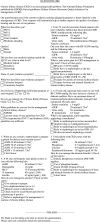Perception of indications for nephrology referral among internal medicine residents: a national online survey
- PMID: 19218472
- PMCID: PMC2637580
- DOI: 10.2215/CJN.03510708
Perception of indications for nephrology referral among internal medicine residents: a national online survey
Abstract
Background and objectives: Many patients with chronic kidney disease (CKD) are seen by primary care physicians who may not be aware of indications or benefits of timely nephrologist referral. Late referral to a nephrologist may lead to suboptimal pre-end stage renal disease care and greater mortality. It is not known whether current postgraduate training adequately prepares a future internist in this aspect of CKD management.
Design, setting, participants, and measurements: The authors performed an online questionnaire survey of internal medicine residents in the United States to determine their perceptions of indications for nephrology referral in CKD management.
Results: Four hundred seventy-nine residents completed the survey with postgraduate year (PGY) distribution of 166 PGY 1,187 PGY 2 and 126 PGY 3. Few residents chose nephrology referral for proteinuria (45%), uncontrolled hypertension (64%), or hyperkalemia (26%). Twenty-eight percent of the residents considered consulting a nephrologist for anemia of CKD, whereas 45% would do so for bone disorder of CKD. Most of the residents would involve a nephrologist at glomerular filtration rate (GFR) <30 ml/min/1.73 m(2) (90%) and for rapid decline in GFR (79%). Many residents would refer a patient for dialysis setup at GFR 15 to 30 ml/min/1.73 m(2) (59%); however, 18% would do so at GFR <15 ml/min/1.73 m(2). Presence of CKD clinic experience or an in-house nephrology fellowship program did not considerably change these perceptions.
Conclusions: Results show that internal medicine residents have widely differing perceptions of indications for nephrology referral. Educational efforts during residency training to raise awareness and benefits of early referral may improve CKD management by facilitating better collaboration between internist and nephrologist.
Figures


References
-
- KDOQI NKF: Clinical practice guidelines for chronic kidney disease: Evaluation, classification and stratification. Am J Kidney Dis 39: S1–S266, 2002 - PubMed
-
- Goransson LG, Bergrem H: Consequences of late referral of patients with end-stage renal disease. J Intern Med 250: 154–159, 2001 - PubMed
-
- Morbidity and mortality of renal dialysis: an NIH consensus conference statement. Consensus Development Conference Panel. Ann Intern Med 121: 62–70, 1994 - PubMed
-
- Go AS, Chertow GM, Fan D, McCulloch CE, Hsu CY: Chronic kidney disease and the risks of death, cardiovascular events, and hospitalization. N Engl J Med 351: 1296–1305, 2004 - PubMed
-
- Goldstein M, Yassa T, Dacouris N, McFarlane P: Multidisciplinary predialysis care and morbidity and mortality of patients on dialysis. Am J Kidney Dis 44: 706–714, 2004 - PubMed
Publication types
MeSH terms
LinkOut - more resources
Full Text Sources
Medical

